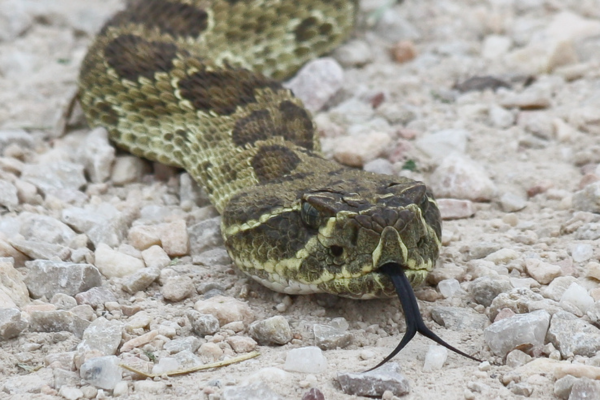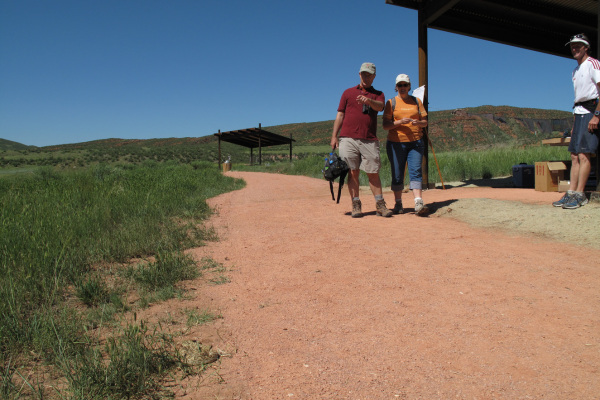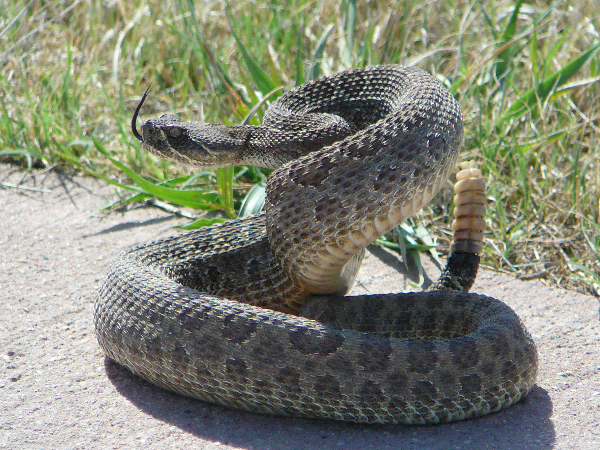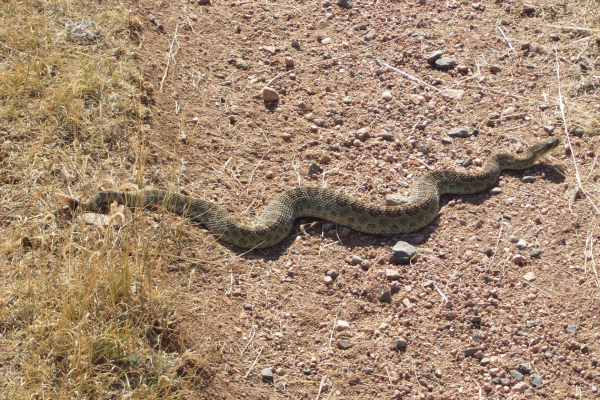Rattlesnake Safety#

Some Fort Collins natural areas have rattlesnakes. Like all wildlife, snakes are a natural part of the ecosystem, and humans need to take certain precautions around them.

When recreating in an area with rattlesnakes, stay near the center of the trail to reduce the changes of surprising a snake in the grass.
If you see a snake on the trail, move slowly away from it. If it is going across the trail, stand still and wait for the snake to move away. Snakes do not see well, but they perceive sudden movement as a threat. If you move away slowly, the snake may not be as likely to see you or feel threatened by you.
Never reach under a rock or log or onto a ledge unless you can clearly see that there is no snake there. Look on the other side of logs or rocks on the trail before stepping over them.
If you need to go off-trail, wear heavy leather high-top boots. Snakes are especially difficult to see in tall grass. Be particularly careful in watching for snakes if tall grasses are growing next to the trail.
Dogs are more likely to die from rattlesnake bites than humans are. You must keep your dog on leash while in natural areas, but also keep them close to you on a short leash when walking in a natural area where rattlesnakes may be encountered.
If the dog is close to you, you may be able to see the rattlesnake before the dog does and stop the dog before it gets close to the snake. Dogs roaming free are more likely to be bitten by rattlesnakes than leashed dogs.
If a Rattlesnake Bites You:
Slowly move away from the snake and remain calm. It is important to get medical care soon. Never run. Exertion causes the heart to pump blood faster, making the venom spread faster. Therefore, running is worse than walking.
- If you have a cell phone, call 911 from where you are. Do not hike back to the trailhead unless emergency personnel advise you to do so.
- If you have no cell phone, remain where you are and have a hiking partner go to an emergency telephone (locations identified above).
- If you are alone and have no cell phone, walk calmly, DO NOT RUN, to an emergency telephone and call for help.
Rattlesnake Behavior#

Snakes would prefer to avoid humans rather than to bite. If a rattlesnake is rattling its tail, it wants to scare you away, not bite you. Be cooperative by slowly moving away.
A snake is most likely to bite if it is surprised or cornered. Give it enough room, and it will probably slither away.
Even an uncoiled snake can bite. If you surprise a snake, it may not have time to coil, but it may still strike out to bite you.
Rattlesnakes are cold-blooded. This means that they move more slowly in cool weather. Since they need heat, they are likely to lay on sun-warmed pavement or rocks to absorb heat. If it gets too hot (over 100 degrees), snakes need to get into the shade (under a bush, rock, or log) to avoid overheating.
Where You Are Likely to Encounter Rattlesnakes#

Rattlesnakes like rocky outcrops, rocky stream courses, and ledges. They may den in mammal burrows, rock crevices, or caves. They may be on the trails – either going across the trail as they move from one place to another or laying on a paved trail to soak up warmth. They also may be in grasses and other vegetation beside a trail.
There are several Fort Collins natural areas where you are likely to encounter rattlesnakes:
- Cathy Fromme Prairie Natural Area.
- Coyote Ridge Natural Area.
- Pineridge Natural Area.
- Reservoir Ridge Natural Area.
- Bobcat Ridge Natural Area.
When You Are Likely To Encounter Rattlesnakes#
Rattlesnakes are active from early spring through mid fall. They hibernate in winter.
Rattlesnakes are more active and more aggressive in spring, shortly after emerging from hibernation. Rattlesnake young are born in August through October. Then the young and adults alike hibernate. Each mother can have from 1 to 25 babies at a time; the typical number is from 4 to 12. So when all these rattlesnakes emerge from hibernation in the spring, there is a flurry of activity. The young ones seem particularly aggressive when they first emerge from hibernation.
In the fall, you may see another flurry of activity as the rattlesnakes scurry to find a warm place to hibernate for the winter.
In between, during the summer, rattlesnakes are not likely to be seen in great numbers, but may be seen individually in their typical habitat at any time.